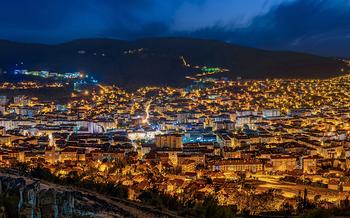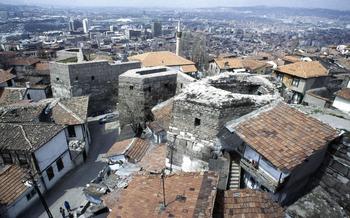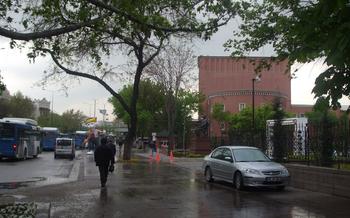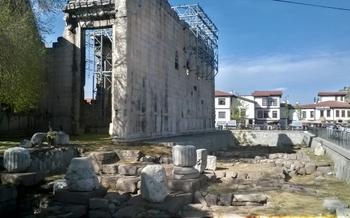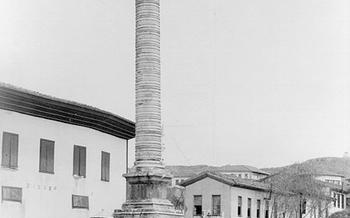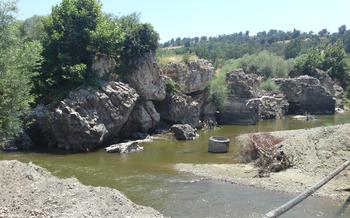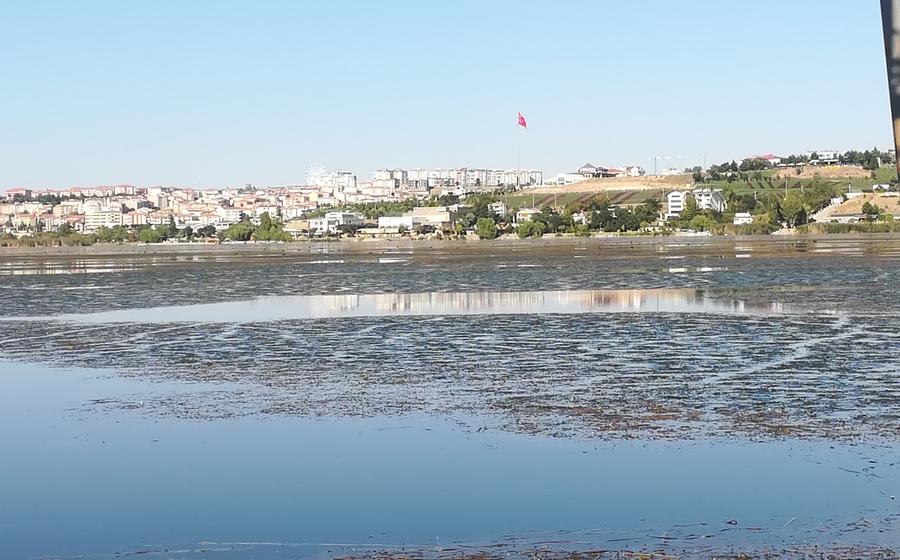
Sarıkaya Roman Bath
- Sarıkaya Roman Bath: A Journey Through Time
- Unveiling the History of the Sarıkaya Roman Bath
- Exploring the Architectural Marvel
- A Glimpse into the Roman Bathing Rituals
- Admiring the Exquisite Mosaics
- Immerse Yourself in the Past: A Virtual Tour
- Practical Information for Visitors
- Uncovering the Archaeological Treasures
- The Sarıkaya Roman Bath in Literature and Film
- Events and Festivals at the Sarıkaya Roman Bath
- The Sarıkaya Village: A Hidden Gem
- Photography Tips for Capturing the Essence
- Accessibility for Visitors with Disabilities
- Conservation and Preservation Efforts
- Insider Tip: Hidden Corners to Explore
Sarıkaya Roman Bath: A Journey Through Time
Historical significance: The Sarıkaya Roman Bath, located in the heart of Turkey's capital, Ankara, stands as a testament to the enduring legacy of the Roman Empire. Built in the 2nd century AD, this remarkably well-preserved bathhouse offers a glimpse into the grandeur and sophistication of Roman culture.
Architectural wonders: The bath's intricate design and impressive architecture showcase the prowess of Roman engineering. Its vaulted ceilings, elegant arches, and imposing stone structures remain intact, providing visitors with a tangible connection to the past.
Well-preserved mosaics: One of the most captivating features of the Sarıkaya Roman Bath is its exquisite collection of mosaics. These intricate artworks, depicting mythological scenes and geometric patterns, have survived remarkably well over the centuries, offering visitors a glimpse into the artistic prowess of the Roman era.
Cultural heritage: The Sarıkaya Roman Bath is not merely a historical site but also a symbol of Turkey's rich cultural heritage. It stands as a testament to the region's diverse past and its enduring connection to the ancient world.
Unveiling the History of the Sarıkaya Roman Bath
The Sarıkaya Roman Bath stands as a testament to the enduring influence of the Roman Empire in Ankara. Its construction dates back to the 2nd century AD, during the reign of Emperor Hadrian, a period of significant architectural and cultural development in the region. The bath served as a vital part of Roman society, providing a place for citizens to cleanse, socialize, and engage in recreational activities.
The bath's strategic location in the heart of Ankara, close to the city's main thoroughfares, highlights its importance as a public facility. It was designed to accommodate a large number of bathers, catering to their needs for relaxation and rejuvenation. The bath's construction reflects the Romans' advanced engineering and architectural skills, employing techniques such as the use of arches and vaults to create expansive interior spaces.
Throughout its history, the Sarıkaya Roman Bath witnessed many significant events and played a crucial role in the daily lives of Ankara's inhabitants. It served as a place for social gatherings, political discussions, and the exchange of ideas, contributing to the city's vibrant cultural landscape. The bath's presence underscores the enduring legacy of the Roman Empire, its influence on urban planning, and its lasting impact on the region's cultural heritage.
Exploring the Architectural Marvel
The Sarıkaya Roman Bath, a testament to ancient Roman engineering, boasts a unique design and layout that sets it apart from other similar structures. Its well-preserved state allows visitors to appreciate the intricate stonework and arches that define its architecture. The bath complex comprises various sections, each serving a specific purpose. Upon entering, visitors are greeted by a spacious frigidarium, where bathers would plunge into cool water to begin their bathing ritual. The tepidarium, with its moderate temperature, served as a transition zone before bathers entered the caldarium, the hottest room in the bath complex. These well-preserved structures provide a glimpse into the advanced engineering and architectural prowess of the Roman Empire.
A Glimpse into the Roman Bathing Rituals
For the ancient Romans, bathing was not just a matter of hygiene but a significant cultural and social practice. The Sarıkaya Roman Bath offers a glimpse into these rituals and customs, providing insights into the daily lives of Roman citizens.
The bathhouse was divided into three main sections: the frigidarium (cold room), the tepidarium (warm room), and the caldarium (hot room). Bathers would typically start in the frigidarium, where they would cool down after exercising or working. They would then move to the tepidarium, which served as a transition room, before entering the caldarium, the hottest room, where they would sweat and cleanse their bodies.
The bathing ritual often involved the use of oils, perfumes, and strigils, a curved metal instrument used to scrape off sweat and dirt. After bathing, Romans would often relax in the adjacent palestra, an open courtyard where they could exercise, socialize, and enjoy massages.
Bathing was also an important social occasion for the Romans. Public baths were a place where people from all walks of life could come together to socialize, exchange news, and conduct business. The baths were also a place where Romans could indulge in gossip and entertainment, as musicians and performers often entertained the bathers.
Admiring the Exquisite Mosaics
Among the awe-inspiring features of the Sarıkaya Roman Bath are its remarkable mosaics, which have been meticulously preserved and restored to their former glory. These intricate artworks, composed of tiny colored tiles, adorn the floors and walls of the various chambers, adding a vibrant and captivating dimension to the site.
The mosaics depict a diverse range of subjects, from mythological scenes and historical events to geometric patterns and floral motifs. Each tile is carefully placed to create a harmonious composition, showcasing the exceptional artistry and craftsmanship of the Roman mosaicists.
One of the most striking mosaics is located in the frigidarium, where visitors can marvel at a stunning depiction of the sea god, Poseidon, surrounded by a retinue of marine creatures. The mosaic's vibrant blues and greens evoke the depths of the ocean, while the intricate details bring the figures to life.
In the tepidarium, another well-preserved mosaic features a hunting scene, with a group of hunters pursuing a variety of animals, including lions, bears, and deer. The mosaic's dynamic composition and lifelike portrayal of the animals create a sense of movement and energy.
The caldarium, the hottest chamber of the bath, is adorned with a mosaic depicting a scene from Roman mythology. The mosaic features the god Bacchus, surrounded by his followers, engaged in a lively celebration. The intricate details and rich colors of the mosaic add to the immersive experience of the caldarium.
These mosaics are not merely decorative elements; they also provide valuable insights into Roman culture and mythology. They offer a glimpse into the beliefs, values, and artistic traditions of the Roman Empire, making them an integral part of the Sarıkaya Roman Bath's historical significance.
Immerse Yourself in the Past: A Virtual Tour
For those unable to visit the Sarıkaya Roman Bath physically, virtual tours offer a remarkable opportunity to immerse themselves in its ancient splendor. These interactive experiences allow you to explore the site from the comfort of your home, with 360-degree views and in-depth information. You can wander through the various chambers, marvel at the intricate mosaics, and learn about the history and significance of this remarkable site.
Virtual tours are an excellent way to delve into the past and gain a deeper understanding of the Roman bathing culture. They provide an accessible and engaging platform for education and exploration, making the Sarıkaya Roman Bath accessible to a global audience. Whether you're a history buff, an architecture enthusiast, or simply curious about ancient civilizations, these virtual experiences offer a unique and immersive journey through time.
Practical Information for Visitors
Location and accessibility:
The Sarıkaya Roman Bath is situated in the Sarıkaya village of the Beypazarı district in Ankara, Turkey. It is easily accessible by road, with well-maintained roads leading to the village. Visitors can also take public transportation, such as buses or taxis, to reach the site.
Visiting hours and admission fees:
The Sarıkaya Roman Bath is open to visitors daily from 8:00 am to 5:00 pm. Admission fees are affordable, making it accessible to both domestic and international tourists. Visitors are encouraged to check the official website or contact the local tourism office for the most up-to-date information on visiting hours and fees.
Guided tours and availability:
For those who want to delve deeper into the history and significance of the Sarıkaya Roman Bath, guided tours are available. Visitors can book guided tours in advance to ensure a spot and learn from knowledgeable and experienced guides. Guided tours are typically offered in various languages, including English and Turkish.
Facilities and amenities offered:
The Sarıkaya Roman Bath site offers several facilities and amenities to enhance the visitor experience. These include a visitor center with information and brochures, restrooms, and a small cafe where visitors can relax and enjoy refreshments. Additionally, there is a gift shop where visitors can purchase souvenirs and memorabilia to remember their visit.
Uncovering the Archaeological Treasures
The Sarıkaya Roman Bath continues to yield valuable insights into Roman culture through ongoing excavations and discoveries. Archaeologists have unearthed a wealth of artifacts, including pottery, coins, jewelry, and tools. These artifacts provide clues about the daily lives of the people who used the bathhouse and offer a glimpse into the material culture of the Roman Empire.
One of the most significant discoveries was a well-preserved statue of the Roman goddess Venus. The statue, which dates back to the 2nd century AD, is a testament to the artistic prowess of the Roman artisans. Other notable finds include a collection of Roman coins, which provide valuable information about the economy and trade in the region during the Roman period.
The ongoing excavations at the Sarıkaya Roman Bath are contributing to our understanding of Roman culture and way of life. The artifacts unearthed at the site provide valuable insights into the daily routines, social customs, and artistic traditions of the Roman people. This archaeological research is essential for piecing together the rich history of the Roman Empire and shedding light on the lives of its citizens.
The Sarıkaya Roman Bath in Literature and Film
The Sarıkaya Roman Bath has captivated the imaginations of writers and filmmakers alike, serving as a backdrop for historical novels, documentaries, and even feature films. In literature, the bath has been featured in historical fiction novels that bring the Roman era to life, immersing readers in the daily lives and customs of the ancient Romans. These novels often weave the bath's rich history and cultural significance into their narratives, creating a vivid and immersive experience for readers.
On the silver screen, the Sarıkaya Roman Bath has graced documentaries that explore the architectural wonders and historical importance of Roman baths. These documentaries delve into the bath's construction, design, and the rituals associated with bathing in Roman culture. They showcase the intricate mosaics, well-preserved structures, and the unique layout of the bath, offering viewers a visual feast of ancient Roman engineering and artistry.
The bath's captivating visuals and historical allure have also attracted the attention of feature filmmakers. In some historical dramas and adventure films, the Sarıkaya Roman Bath has been featured as a setting for key scenes, adding authenticity and depth to the storytelling. These cinematic portrayals have helped popularize the site and introduce it to a broader audience, inspiring wanderlust and a desire to explore its ancient wonders.
Through literature and film, the Sarıkaya Roman Bath continues to captivate and inspire, serving as a muse for creative expression and a reminder of the enduring legacy of the Roman Empire.
Events and Festivals at the Sarıkaya Roman Bath
The Sarıkaya Roman Bath is not only a historical site but also a vibrant cultural hub that hosts various events and festivals throughout the year. These events provide an immersive experience for visitors, allowing them to delve deeper into the cultural heritage associated with the site.
One of the most popular events is the annual Roman Bath Festival, held during the summer months. This festival celebrates the rich history of the Roman Empire and its influence on the region. Visitors can enjoy traditional Roman music, witness gladiator battles, and participate in hands-on workshops related to Roman culture.
Another highlight is the Sarıkaya Village Festival, which showcases the local traditions and way of life. Visitors can indulge in delicious Turkish cuisine, shop for handmade crafts, and experience traditional folk performances. These events offer a unique opportunity to connect with the local community and gain insights into their culture.
By attending these events and festivals, visitors can not only appreciate the historical significance of the Sarıkaya Roman Bath but also immerse themselves in the vibrant cultural tapestry of the region. These events add a dynamic and engaging dimension to the overall visitor experience, making it a truly memorable and enriching journey through time.
The Sarıkaya Village: A Hidden Gem
Nestled amidst the rustic charm of the Turkish countryside, the enchanting village of Sarıkaya beckons travelers to delve into its rich cultural tapestry. Embrace the opportunity to wander through its cobblestone streets, where time seems to stand still, and discover a treasure trove of local handicrafts, reflecting the village's enduring traditions. Delight your taste buds with authentic Turkish cuisine, savoring the flavors of home-cooked meals prepared with love and fresh, locally sourced ingredients. Immerse yourself in the vibrant culture of the village, where locals warmly welcome visitors to share in their customs and traditions. Sarıkaya is a testament to Turkey's rich heritage, offering a glimpse into a way of life that has remained steadfast amidst the passage of time. Exploring the village alongside the Roman bath enhances the overall travel experience, providing a deeper connection to the region's history and culture.
Photography Tips for Capturing the Essence
The Sarıkaya Roman Bath offers a treasure trove of photographic opportunities for travelers and enthusiasts alike. To capture the essence of this ancient site, consider the following tips:
-
Lighting: The best time to photograph the Roman bath is during the golden hours of sunrise and sunset. The warm, diffused light enhances the textures and colors of the stone, creating a magical atmosphere.
-
Angles: Experiment with different angles to showcase the unique features of the bath. Capture the grandiosity of the arches from below, or shoot from a higher vantage point to include the surrounding landscape.
-
Composition: Pay attention to the composition of your shots. Incorporate leading lines, such as the stone pathways or arches, to draw the viewer's eye into the image.
-
Details: Don't forget to focus on the intricate details of the mosaics and carvings. These elements add depth and character to your photographs.
-
Storytelling: Aim to capture the spirit and history of the Roman bath through your images. Create a visual narrative that transports the viewer back in time, allowing them to experience the grandeur of this ancient site.
Accessibility for Visitors with Disabilities
The Sarıkaya Roman Bath welcomes visitors with disabilities and offers various accessibility features to ensure an inclusive experience. The site is wheelchair accessible, with ramps and designated pathways allowing for easy movement throughout the complex. Visitors with mobility challenges can request assistance from the friendly staff, who are always ready to provide support and guidance. Adapted restrooms and facilities are also available, ensuring that everyone can comfortably explore the ancient site. The combination of accessibility features and helpful staff makes the Sarıkaya Roman Bath a welcoming and enjoyable destination for all visitors.
Conservation and Preservation Efforts
The Sarıkaya Roman Bath stands as a testament to the enduring legacy of Roman culture. However, the passage of time and various environmental factors have taken their toll on this ancient treasure. Recognizing its immense historical significance, extensive conservation and preservation efforts have been undertaken to protect and restore the site for future generations.
Archaeologists, historians, and conservators collaborate to meticulously document, analyze, and address the challenges faced by the Roman bath. Structural reinforcement, restoration of mosaics, and ongoing excavations are diligently carried out to ensure the integrity and preservation of this remarkable site.
The success of these conservation efforts relies heavily on responsible tourism practices. Visitors are encouraged to respect the fragile nature of the ruins, refrain from touching or damaging the mosaics, and adhere to designated pathways to minimize impact on the site. By promoting responsible tourism, visitors can actively contribute to the preservation of this invaluable heritage.
Through these dedicated conservation initiatives, the Sarıkaya Roman Bath continues to captivate visitors with its architectural grandeur and historical significance, serving as a living testament to the enduring legacy of the Roman Empire.
Insider Tip: Hidden Corners to Explore
As you wander through the Sarıkaya Roman Bath, keep an eye out for hidden corners and lesser-known areas that offer unique perspectives and photo opportunities. One such spot is the secluded chamber beneath the main bathing halls. This atmospheric space, often overlooked by visitors, features intricate mosaics and stonework that tell a story of their own.
Another hidden gem is the rooftop terrace, which offers panoramic views of the surrounding countryside. From here, you can capture stunning shots of the bath's ruins against the backdrop of the rolling hills. Just be sure to climb the stairs carefully, as they can be slippery.
For those seeking a truly unique experience, venture beyond the main complex to explore the surrounding ruins. Here, you'll find remnants of ancient walls, arches, and even a few intact columns. These hidden corners provide a glimpse into the vastness of the Roman Empire and the grandeur of its architecture.
Remember, while exploring these hidden corners, respect the fragile nature of the ruins and tread carefully to avoid any damage. Embrace the opportunity to discover the lesser-known secrets of the Sarıkaya Roman Bath and create a truly memorable experience.


